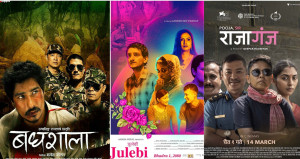Movies
Beauty might not be superficial but this film is
‘Poi Paryo Kale’ attempts to show that skin colour doesn’t matter, but then puts all of its fair-skinned actors in makeup to make them look darker..png&w=900&height=601)
Abhimanyu Dixit
The poster for the new film Poi Paryo Kale (My husband is dark) features Saugat Malla as a groom beside his two ‘brides’ Pooja Sharma and Shristi Shrestha. But look closer and you might notice something strange. Saugat Malla, the infamous Haku Kaaley of Loot (2011), has been turned even darker. You might think this is the result of a poor Photoshop job, but watch the film and you’ll realise that the dark skin tone is makeup. You’ll also notice that everyone who is supposed to be a dark character in the film has had their skin coloured darker.
Blackface has a racial history. In the West, white people often donned dark makeup to portray minorities. Before cinema, blackface was prevalent in minstrel shows where white men with black makeup perpetuated the stereotype that members of the black community were criminal, lazy, and hypersexual. The black community is fighting those stereotypes even today.
Earlier this year, Canadian Prime Minister Justin Trudeau had to publicly apologise after photos of him in dark makeup emerged. Trudeau had put on a dark makeup to look like characters and singers of a different race. The photos were from high school and college parties more than 20 years ago, yet they were deemed highly offensive and racist. Many had surmised that the photos would hurt his chances in the recently concluded Canadian election.
But let’s assume that the filmmakers behind Poi Paryo Kale do not know any better. This film forces the ‘lesson’ that a person’s personality is not dictated by the level of skin pigmentation. But they employ fair-skinned actors and darken their skin. The filmmakers think they’re trying to break the stigma around being dark, but by making their actors don blackface, they’re further cementing the stigma.
Poi Paryo Kale is about Pooja (Sharma), a young fair-skinned girl who hates everything dark or black. Why? Well, she’s had a lifetime of bad experiences with ‘black’ things. A narrator (Kedar Ghimire) explains this in an insensitive montage designed to play out as a joke.
The narrator says that the first person Pooja saw after she was born was a dark nurse, although it is unclear why this is a bad thing. Growing up, a black dog bites her, and a dark compounder gives her rabies injections. While all of these are insensitive, the most racist is when the narrator says “Kofi Annan bhanda pani kaalo keta le kaalo khaldo ma falidiyeko”—a kid darker than even Kofi Annan once pushed Pooja inside a dark hole. The late Annan, former secretary-general of the United Nations, is reduced to the colour of his skin.
This cringe-worthy montage appears in the first 15 minutes and there is still two more hours to go.
The plot goes on to become more and more illogical—and insensitive, if that’s possible. Pooja rejects a love proposal from Radheshyam (Kiran Nepali), a Madhesi man with an exaggerated accent. And no surprises, he also has blackface makeup on. Pooja blatantly tells him to his face that she hates everything that is black or dark.
Pooja announces to her friends that she’ll marry a “ramro goro keta”—a nice, fair man. She meets Aakash (Sohit Manandhar), who has fair skin, and she dates him for a while. But she discovers that he is a father to two children and has a dark-skinned wife (Surakhshya Panta in blackface).
Betrayed, Pooja asks her parents to find her a groom. Enter Gaurab (Malla), a rich, successful, soft-spoken man with dark skin. Pooja’s parents are elated to find this gem of a suitor for her but knowing that their daughter will never agree to marry someone dark, they trick her. Pooja only sees Gaurab’s face during the wedding ceremony and despite protesting dramatically, Pooja ends up married.
Pooja goes on to live with Gaurab as a sad, wallowing bride. Good guy Gaurab gives Pooja space to deal with her issues but Pooja is ashamed of Gaurab. She hides her husband from all her friends, as she knows they’ll taunt her for the rest of her life if they find out about her marriage to a dark man. To make matters worse, one of her friends, Kriti (Shristi Shrestha), announces that she’ll be staying with Pooja for a few days. Pooja tells Gaurab of her dilemma, and Gaurab agrees to help.
They devise a plan to lie to Kriti. They introduce Nil (Aakash Shrestha), Gaurab’s fair-skinned friend, as Pooja’s husband. If you’ve been following so far, you should know by now that since Nil is fair, Nil must be bad. And true to form, he is an alcoholic womaniser who talks in double entendres. Nil falls for Kriti on first sight, but unlike Pooja, Kriti is attracted to dark men. So Nil dons blackface and introduces himself to Kriti as a darker twin brother.
This is the primary problem with the film. Although its aim is to go beyond skin colour, all it does is show its fair-skinned characters as bad and dark-skinned characters as good. There’s no argument in favour of dark skin or against colourism. For Sishir Rana, who is the writer, director, and a supporting actor, this is an epic fail.
Colourism is real in all of South Asia, including Nepal. Whether it’s selecting partners for marriage or calling someone ‘kale’ in school, dark skin is looked down upon and face-bleaching products masquerading as fairness creams are sold to whiten them up.
In Nepali cinema, where very few dark-skinned actors are given leading roles, painting a fair-skinned actor’s face black is worse. This doesn’t just disregard dark-skinned actors but also perpetuates the stereotype that people should be judged by the colour of their skin.
In Loot, Haaku Kale was a breakout character, despite his dark skin. It wasn’t necessary to darken Malla’s skin then, no one wanted him any darker. But here, since the film is about skin colour, Malla is visibly darker.
But the makeup person, Santu Tamang, deserves special mention, just not for the blackface. Pooja calls herself beautiful but Tamang’s make-up never attempts to hide her blemishes. She has red blotches, pimples, pores and rashes on her skin. It’s as if Tamang is saying that the woman who judges dark-skinned people is not blemish free herself. I really hope that’s the case.
In any case, none of the characters should be proud of their acting either, because they are all horrendous. Malla’s portrayal of a nice-guy is modesty, shyness, and being quiet. In contrast, Sharma the female lead over-reacts in every situation. If the scene demands her to be happy, she is bubbly, and if she’s required to be sad, she is absolutely distraught. We’re also never sure if Shrestha is supposed to be a caricature, as she says ‘like’ before every sentence and says ‘oh my god’ as a go-to reaction. And for some strange reason, she turns twice in slow motion before exiting scenes.
What’s surprising is how none of the actors seem to have protested. The actors in this film are from the current generation of educated, aware people. Malla is a veteran actor and Sharma has worked as a producer. Shrestha, who has represented Nepal globally as Miss Nepal, was educated abroad. But in the film, they’re puppets. It’s very difficult for me to understand what persuaded these actors to accept a role like this.
The problem with films in Nepal is that they are never watched critically. Critical, analytical viewers shun these kinds of films and so, they are never discussed. But these are cultural texts that are consumed by a massive audience and they deserve to be commented upon. Nepalis who are even slightly media-literate must see this as an opportunity to speak out against insensitivity, and condemn these kinds of films.
Poi Paryo Kale
Starring: Saugat Malla, Pooja Sharma, Shristi Shrestha
Director: Sishir Rana
Makeup: Santu Tamang
Star: 1 out of 5




 14.12°C Kathmandu
14.12°C Kathmandu













